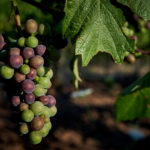
The effects of water on tannin levels in grape development – Part four: How does this help us understand dry farmed sites?
In February I had the pleasure of speaking at the Oregon Wine Industry Symposium on a panel talking about grape and wine tannins. Anna Matzinger, Steve Price and I wanted to clarify what tannins are, how their levels in wine affect texture and structure of the wine, where tannins come from, the role of soil moisture on grape tannin levels and how harvest date affects quality of tannins.
I was tasked with talking about the relationship between soil water status and grape tannin levels. It was a great opportunity to improve my understanding of the relationship, and helped me come to terms with the difference between dry farming here in the Willamette Valley and the irrigated vineyards in Southern Oregon. On dry farmed sites factors like soil type, depth and texture, along with the seasonal rainfall have a profound effect on tannin level. In vineyards where there isn’t enough soil moisture to sustain the vines for the entire season, supplementary irrigation is needed. In those vineyards you have more control over the tannin levels of the grapes. To understand this topic and prep for my panel discussion, I studied three key disciplines: 1) soil science; 2) plant physiology; and 3) irrigation management.
Before I get into this I will say that I think the Internet is great for researching topics but I really like books.
PART FOUR: HOW DOES THIS HELP US UNDERSTAND DRY FARMED SITES?
Now that you understand how soil science, plant physiology & irrigation affect grape growing, how will this help us understand dry farmed sites?
- Sites with deep soils and high PAW, like those on the valley floor, never have enough stress to restrict shoot growth or berry size. They end up producing huge canopies with high amounts of shading and large berries that lack concentration of phenolic compounds.
- In years where we have low summer rainfall and the shoot tips stop growing before veraison we can confidently predict that the tannin and anthocyanin levels will be higher than average. Subsequent wine quality will also be higher than average.
- When winemakers talk about the differences in tannin structure between marine sedimentary soils and volcanic soils this could be explained more by the soil tension during the season than the mineral content of the soils.
- Site selection trumps winemaking every time. You can’t make great wine from deep fertile soils.
